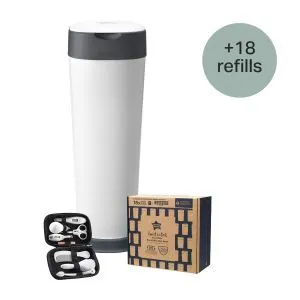
Ultimate XL Nappy Disposal Bundle with 18 Refills
Bundle & Save 40%
Subscription orders can be cancelled at anytime. Free delivery on all subsequent subscription orders. Find out more about subscriptions.
They’re easy and fuss free
Your products are automatically sent to you
You save up to 10% when you sign up for a subscription
You can cancel at any time

Many parents wonder if giving their baby a dummy will interfere with their breastfeeding journey. While there are some things to consider when it comes to using dummies while breastfeeding, it's important to remember that they don't have to be a barrier to a successful breastfeeding journey.
Babies sometimes need additional comfort or reassurance, and that's where dummies can come in handy. With the right approach, you can safely use dummies to soothe your baby without compromising your milk supply or your breastfeeding routine.
In this simple guide, we'll give you some practical tips and advice on how to use dummies when breastfeeding, so you can make informed decisions about what’s best for you and your baby.
It’s widely known that breastfeeding offers lots of benefits for both parents and babies.
For babies, breast milk provides all the necessary nutrients, protects against infections, and supports healthy development.
For parents, breastfeeding is free and convenient. It can also help to reduce the risk of postpartum depression and strengthen the bond with their baby.
Dummies (also known as pacifiers or soothers) are small, nipple-shaped objects that babies can suck on.
They are often used to soothe babies and satisfy their sucking reflex, and babies with colic sometimes find comfort from sucking a soother in between feeds.
While dummies can be a helpful tool for soothing babies, it's important to use them in moderation and ensure they don't interfere with your breastfeeding routine. A good approach is to offer the dummy primarily for comfort and sleep, rather than as a constant pacifier.
Explore the Range
Let’s run through some key things to consider when looking for a dummy for a breastfed baby.
If you are breastfeeding and decide to give your baby a dummy, you should wait until your baby’s breastfeeding schedule is well-established (usually at around 4 to 6 weeks old) before you introduce a soother into their routine.
This is because there are some ways that a dummy can negatively impact breastfeeding. These include:
If you notice any signs of nipple confusion or difficulty latching, it might help to limit or temporarily stop dummy use. This could be a sign that the baby is becoming confused between your nipple and their soother.
Ultimately, the best approach is to find a balance that works for you and your baby and speak to a lactation consultant if you have any concerns.